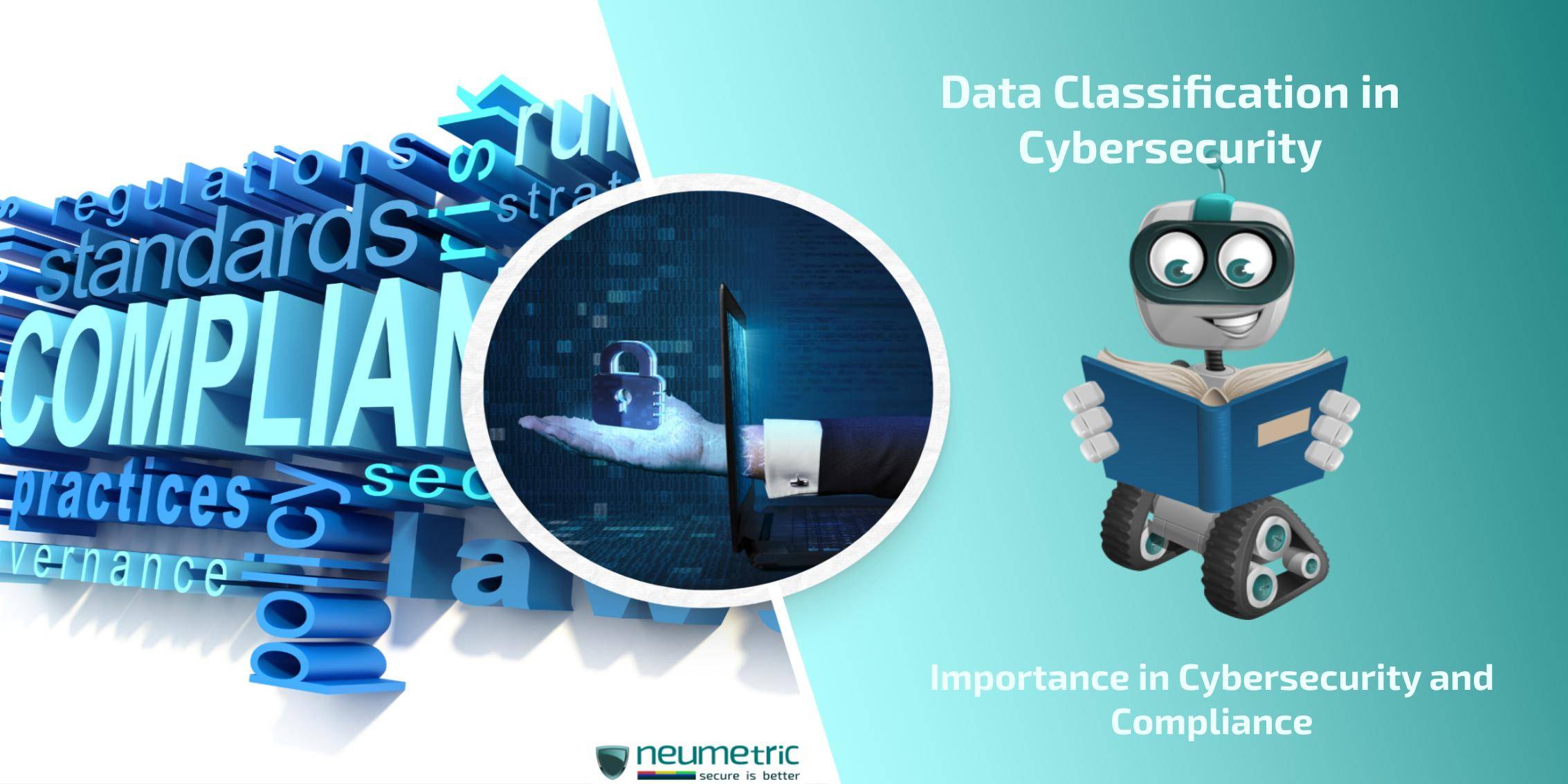Table of Contents
ToggleData Classification in Cybersecurity: Importance in Cybersecurity & Compliance
Introduction
As cyber threats continue to escalate in sophistication & frequency, organizations must adopt robust strategies to protect their most valuable assets. Data classification is a critical process that serves as the gatekeeper to effective cybersecurity & regulatory compliance, ensuring the protection of an organization’s priced assets i.e data.
The Paramount Importance of Data Classification in Cybersecurity
Data classification is the foundation upon which a comprehensive cybersecurity strategy is built. By categorizing data based on its sensitivity & value to the organization, businesses can implement appropriate security controls & access protocols. This proactive approach not only mitigates the risk of data breaches but also ensures compliance with various industry regulations & data protection laws (such as EU GDPR & HIPAA), safeguarding the organization from potentially devastating consequences.
Identifying & Fortifying the Crown Jewels
Every organization possesses a set of “crown jewels” – data assets that are critical to its operations, intellectual property [IP] & competitive advantage. These sensitive assets may include financial records, customer data, trade secrets, proprietary algorithms & other highly valuable information. Failure to properly classify & protect these crown jewels can lead to catastrophic consequences, such as financial losses, reputational damage, legal liabilities & a compromised market position.
Through data classification, organizations can identify & prioritize the protection of their most valuable data assets. By implementing robust access controls, encryption mechanisms & continuous monitoring systems, businesses can ensure that only authorized individuals can access & handle sensitive information, minimizing the risk of unauthorized access, theft or misuse. This proactive approach not only enhances cybersecurity but also fosters a culture of data stewardship & accountability within the organization.
Enabling Targeted & Efficient Security Measures
Data classification allows organizations to allocate their security resources strategically, implementing stronger safeguards for their most sensitive data while optimizing resources for less critical information. This targeted approach ensures that organizations can effectively protect their crown jewels while maintaining operational efficiency & cost-effectiveness.
By categorizing data based on its sensitivity, businesses can tailor their security measures accordingly. For instance, highly sensitive data may require stringent access controls, advanced encryption techniques, real-time monitoring & regular security audits, while less critical data may necessitate more basic security measures. This risk-based approach enables organizations to prioritize their security efforts & allocate resources efficiently, striking the right balance between protection & productivity.
Moreover, data classification facilitates the implementation of a defense-in-depth [DiD] strategy, where multiple layers of security controls are employed to protect data assets. This multi-layered approach enhances overall cybersecurity posture, as it reduces the likelihood of a single point of failure & provides redundancy in case one layer of protection is breached.
Data Classification as a Compliance Catalyst
In addition to its vital role in cybersecurity, data classification is a cornerstone of regulatory compliance. Numerous industry regulations & data protection laws, such as the General Data Protection Regulation [GDPR], the Health Insurance Portability & Accountability Act [HIPAA], the Payment Card Industry Data Security Standard [PCI DSS] & the California Consumer Privacy Act [CCPA], mandate specific requirements for the handling & protection of sensitive data.
Adhering to Data Protection Laws
Data protection laws & regulations have become increasingly stringent in recent years, imposing strict guidelines on how organizations must handle & safeguard personally identifiable information [PII], protected health information [PHI], financial data & other sensitive information. Not complying with these regulations can incur severe financial penalties, legal repercussions & irreparable reputational damage.
By implementing a robust data classification program, organizations can ensure that they are adhering to the relevant data protection laws & regulations. This involves correctly identifying & classifying sensitive data, implementing appropriate security controls, maintaining detailed records of data processing activities & demonstrating accountability through comprehensive documentation & auditing processes. Data classification provides a systematic approach to demonstrating compliance & minimizing the risk of regulatory violations, which can cost organizations dearly in terms of fines, legal fees & lost business opportunities.
Facilitating Effective Data Governance & Stewardship
Data classification is a critical component of effective data governance, which encompasses the processes, policies & procedures that govern the management & utilization of data within an organization. By classifying data according to its sensitivity & value, organizations can establish clear guidelines for data handling, access controls, retention periods & disposal processes.
Effective data governance not only supports regulatory compliance but also promotes data integrity, consistency & accessibility across the enterprise. This, in turn, enhances decision-making processes, operational efficiency & overall business performance. Furthermore, it fosters a culture of data stewardship, where employees at all levels understand & uphold the principles of responsible data management, further strengthening the organization’s cybersecurity posture & regulatory compliance efforts.
Implementing a Robust Data Classification Strategy: A Multifaceted Approach
Developing & implementing an effective data classification strategy is a multifaceted process that requires careful planning, execution & continuous monitoring. Here are some key considerations:
Conducting a Comprehensive Data Asset Inventory
The first step in data classification is to conduct a thorough inventory of all data assets within the organization. This includes identifying the various types of data, their locations (on-premises, cloud or hybrid environments) & their sensitivity levels based on factors such as Confidentiality, Integrity & Availability [CIA] requirements.
To ensure a comprehensive understanding of the organization’s data landscape, it is essential to involve stakeholders from various departments, including IT, legal, compliance & business units. This collaborative approach ensures that all data assets are accounted for & that the classification process is aligned with the organization’s unique needs & regulatory requirements.
Establishing Clear Criteria for Data Sensitivity Levels
Once the data assets have been identified, organizations must establish clear criteria for determining data sensitivity levels. These criteria should take into account regulatory requirements, industry best practices & the potential impact of a data breach or unauthorized access on the organization’s operations, reputation & financial stability.
Common sensitivity levels may include Public, Internal, Confidential & Restricted. Public data is information that can be shared freely with the general public, while internal data is intended for use within the organization only. Confidential data typically includes sensitive information that requires access controls & protective measures, such as customer data, intellectual property [IP] or financial records. Restricted data is the most sensitive category, often containing highly regulated or classified information that requires stringent security controls & access limitations.
By establishing well-defined criteria for data sensitivity levels, organizations can ensure consistency & accuracy in the classification process, reducing the risk of human error or subjective interpretations.
Developing & Implementing Comprehensive Policies & Procedures
With a clear understanding of data assets & sensitivity levels, organizations must develop & implement robust policies & procedures for data classification, handling & protection. These policies should outline the roles & responsibilities of various stakeholders, define access controls & establish guidelines for data storage, transmission & disposal.
Comprehensive training & awareness programs are crucial to ensure that all employees understand & adhere to the data classification policies & procedures. Regular audits & monitoring mechanisms should be implemented to identify & address any deviations or potential vulnerabilities, ensuring ongoing compliance & reinforcing a culture of data stewardship within the organization.
Leveraging Automation & Advanced Technology Solutions
While data classification can be performed manually, the sheer volume & complexity of data within modern organizations often necessitate the use of automation & advanced technology solutions. Data classification tools & software can greatly enhance the efficiency & accuracy of the classification process, reducing the risk of human error & enabling organizations to scale their efforts effectively.
These solutions typically leverage Machine Learning [Ml] Algorithms, Natural Language Processing [Nlp], Content Analysis & Pattern Recognition techniques to automatically classify data based on predefined rules & criteria. Additionally, Data Loss Prevention [DLP] tools can monitor & control the flow of sensitive data, preventing unauthorized access, transmission or exfiltration & providing real-time alerts & incident response capabilities.
Furthermore, advanced technologies such as Cloud Access Security Brokers [CASBs] & Cloud Data Loss Prevention [CDLP] solutions can extend data classification & protection capabilities to cloud-based environments, ensuring consistent security & compliance across hybrid infrastructures.
Continuous Monitoring, Improvement & Integration
Data classification is not a one-time exercise; it is an ongoing process that requires continuous monitoring & improvement. As an organization’s data landscape evolves, with new data sources, formats & regulatory requirements, the data classification strategy must adapt accordingly.
Regular reviews & assessments should be conducted to ensure that data classification policies & procedures remain up-to-date & aligned with the organization’s evolving needs & risk profile. Additionally, organizations should leverage insights from security incidents, audits & user feedback to identify areas for improvement & optimize their data classification strategies.
Moreover, data classification should be integrated with other cybersecurity & risk management processes, such as vulnerability management, incident response & business continuity planning. This integration ensures a holistic approach to data protection & enables organizations to respond effectively to emerging threats & regulatory changes, minimizing the potential impact on business operations & stakeholder trust.
Embracing Data Classification as a Strategic Imperative
In today’s data-driven landscape, where cyber threats & regulatory scrutiny are constantly evolving, data classification has emerged as a strategic imperative for organizations of all sizes & across industries. By embracing data classification as a cornerstone of their cybersecurity & compliance strategies, businesses can unlock numerous benefits:
Enhanced Cybersecurity Posture
Data classification enables organizations to identify & prioritize the protection of their most valuable data assets, mitigating the risk of data breaches, unauthorized access & cyber-attacks. By implementing robust security controls & access protocols tailored to the sensitivity levels of their data, businesses can fortify their defenses & maintain a strong cybersecurity posture in the face of ever-evolving threats.
Regulatory Compliance & Risk Mitigation
Adhering to data protection laws & industry regulations is no longer optional; it is a legal & ethical obligation. Data classification provides a systematic approach to demonstrating compliance with these regulations, minimizing the risk of potentially devastating fines, legal repercussions & reputational damage resulting from non-compliance.
Fostering a Culture of Data Stewardship
By implementing a comprehensive data classification strategy, organizations can cultivate a culture of data stewardship, where employees at all levels understand & uphold the principles of responsible data management. This cultural shift not only reinforces cybersecurity & compliance efforts but also promotes data integrity, consistency & accessibility across the enterprise, enabling better decision-making & driving operational excellence.
Competitive Advantage & Stakeholder Trust
Organizations that prioritize data classification & protection can gain a significant competitive advantage. By demonstrating a commitment to safeguarding sensitive information & adhering to industry best practices, businesses can foster trust among customers, partners & other stakeholders, enhancing their reputation & positioning themselves as leaders in their respective markets.
Conclusion
Through the implementation of a thorough data classification plan, organizations may strengthen their regulatory compliance, manage their data assets & realize their full potential. Data classification will continue to be an essential part of an organization’s overall security posture & risk management strategy as the cybersecurity landscape changes & regulatory scrutiny increases. Organizations hoping to prosper in a more regulated & data-driven business climate must embrace data classification; it is no longer a choice.
Organizations may reduce cyber risks & guarantee compliance by emphasizing data classification & developing a data stewardship culture. They can also gain a competitive edge by showcasing their dedication to protecting sensitive data & adhering to industry best practices. Data classification emerges as a potent differentiator, allowing businesses to create enduring connections with partners, stakeholders & customers in an era where trust & reputation are priceless assets.
In the end, becoming an expert in data classification is a journey that calls for ongoing development, modification & integration with more comprehensive risk management & cybersecurity procedures. It is evidence of an organization’s commitment to safeguarding its most important resources, making sure business continues & upholding stakeholder confidence in a constantly evolving digital environment.
Key Takeaways
- Data classification is the foundation of a robust cybersecurity strategy & a cornerstone of regulatory compliance, enabling organizations to protect their most valuable data assets & adhere to data protection laws.
- Implementing an effective data classification strategy involves conducting a comprehensive data asset inventory, establishing clear criteria for sensitivity levels, developing policies & procedures, leveraging automation & advanced technologies & continuously monitoring & improving the process.
- Data classification supports targeted & efficient security measures, facilitates effective data governance & stewardship & enhances an organization’s overall cybersecurity posture & competitive advantage.
- Embracing data classification as a strategic imperative enables organizations to mitigate cyber risks, ensure regulatory compliance, cultivate a culture of data stewardship & foster stakeholder trust.
Frequently Asked Questions [FAQ]
Why is data classification crucial for effective cybersecurity?
Data classification is essential for cybersecurity because it enables organizations to identify & prioritize the protection of their most sensitive & valuable data assets. By categorizing data based on its sensitivity & value, businesses can implement appropriate security controls, access protocols & monitoring mechanisms to mitigate the risk of data breaches, unauthorized access & other cyber threats. It serves as the foundation for a comprehensive cybersecurity strategy, ensuring that resources are allocated effectively to protect the organization’s crown jewels.
How does data classification support regulatory compliance?
Data classification is a cornerstone of regulatory compliance. Many industry regulations & data protection laws, such as GDPR, HIPAA, PCI DSS & CCPA, mandate specific requirements for the handling & protection of sensitive data, including personally identifiable information [PII], protected health information [PHI] & financial data. By correctly classifying & safeguarding sensitive data according to these regulations, organizations can demonstrate compliance, avoid potential fines & legal repercussions & maintain stakeholder trust.
What are the common data sensitivity levels used in data classification?
Common data sensitivity levels used in data classification include public, internal, confidential & restricted. Public data can be shared freely with the general public, while internal data is intended for use within the organization only. Confidential data typically includes sensitive information that requires access controls & protective measures, such as customer data or intellectual property. Restricted data is the most sensitive category, often containing highly regulated or classified information that requires stringent security controls & access limitations.
How can organizations ensure consistency & accuracy in data classification?
To ensure consistency & accuracy in data classification, organizations should:
- Establish clear criteria for determining data sensitivity levels, taking into account regulatory requirements, industry best practices & potential impact.
- Develop comprehensive policies & procedures for data classification, handling & protection, outlining roles & responsibilities, access controls & data management guidelines.
- Provide comprehensive training & awareness programs for employees to ensure understanding & adherence to the classification policies.
- Implement regular audits & monitoring mechanisms to identify & address deviations or potential vulnerabilities.
- Leverage automation & technology solutions, such as data classification tools & machine learning algorithms, to enhance efficiency & accuracy.
How can data classification support effective data governance & stewardship?
Data classification is a critical component of effective data governance. By classifying data according to its sensitivity & value, organizations can establish clear guidelines for data handling, access controls, retention periods & disposal processes. This promotes data integrity, consistency & accessibility across the enterprise, enhancing decision-making processes, operational efficiency & overall business performance. Furthermore, data classification fosters a culture of data stewardship, where employees understand & uphold the principles of responsible data management, strengthening the organization’s cybersecurity posture & regulatory compliance efforts.





